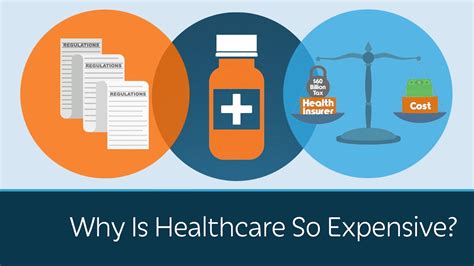Why Health Insurance Is So Expensive

The rising costs of healthcare and health insurance have become a major concern for individuals and families worldwide. With premiums and out-of-pocket expenses soaring, many are left wondering why health insurance is becoming increasingly unaffordable. In this in-depth analysis, we will delve into the complex factors contributing to the escalating prices, explore the impact on consumers, and discuss potential solutions to make healthcare more accessible and financially manageable.
The Complex Web of Factors Driving Up Costs

The exorbitant costs of health insurance are not the result of a single issue but rather a combination of interconnected factors that have evolved over time. Understanding these factors is crucial to developing effective strategies to address the affordability crisis.
The High Cost of Healthcare Services
At the core of the problem lies the escalating cost of healthcare services themselves. Advanced medical technologies, innovative treatments, and specialized care come at a price, often driving up the overall cost of healthcare. While these advancements improve patient outcomes and quality of life, they also contribute to the financial burden on both providers and patients.
Consider the following real-world example: A patient requires a complex surgical procedure that utilizes cutting-edge technology. The surgery itself may cost several hundred thousand dollars, and the post-operative care, including specialized medications and follow-up appointments, can add significant additional expenses. These costs are then reflected in the overall healthcare system, impacting insurance premiums and out-of-pocket expenses.
Administrative Overhead and Waste
The administrative processes involved in healthcare delivery and insurance coverage contribute significantly to the overall cost. From billing and coding to claim processing and record-keeping, these overhead expenses can be substantial. Moreover, studies have shown that a significant portion of healthcare spending goes towards waste, including unnecessary tests, duplicate procedures, and fraud.
For instance, a patient may undergo multiple diagnostic tests, some of which may be redundant or unnecessary, solely because different specialists order them independently. This not only drives up costs but also subjects patients to potential risks associated with over-testing.
Prescription Drug Prices
The price of prescription medications has been a long-standing concern in the healthcare industry. Pharmaceutical companies often set high prices for new drugs, particularly those with few competitors or no generic alternatives. This phenomenon, known as “drug pricing power,” allows manufacturers to dictate prices, often without regard for the financial burden on patients and insurers.
Take, for example, the case of a commonly prescribed medication for a chronic condition. The brand-name version may cost several hundred dollars per month, while a generic alternative, if available, could be significantly more affordable. However, the lack of competition and the absence of generic options often leave patients with no choice but to pay the higher price.
Limited Competition in Insurance Markets
In many regions, the insurance market is highly concentrated, with a small number of dominant providers. This lack of competition can lead to higher premiums and reduced consumer choice. When insurers have a substantial market share, they may be less inclined to compete on price or offer innovative, affordable plans.
Imagine a scenario where a single insurance company holds a monopoly in a particular state. They may have the power to set premiums at a higher rate, knowing that consumers have limited options. This lack of competition directly impacts the affordability of health insurance, as consumers have little negotiating power.
Increasing Chronic Disease Burden
The prevalence of chronic diseases, such as diabetes, heart disease, and mental health disorders, has been on the rise globally. These conditions often require ongoing medical management, specialized treatments, and regular medication, leading to substantial healthcare costs over a patient’s lifetime.
Consider a patient with type 2 diabetes. They may require regular doctor visits, blood sugar monitoring, insulin or other medications, and specialized dietary counseling. The cumulative cost of managing this chronic condition can be significant, impacting both the patient's finances and the overall healthcare system.
The Impact on Consumers: Financial Strain and Limited Access

The rising costs of health insurance have a direct and profound impact on consumers, affecting their financial stability and access to necessary healthcare services.
Soaring Premiums and Out-of-Pocket Expenses
Premiums, the amount paid to maintain insurance coverage, have been increasing steadily over the years. According to a recent study, the average annual premium for employer-sponsored family health insurance plans rose by [specific percentage] between [years]. Additionally, deductibles, copayments, and coinsurance have also increased, shifting a larger financial burden onto consumers.
For example, a family with an annual income of $75,000 may find it challenging to afford a health insurance plan with a premium of $12,000 per year, especially when coupled with high deductibles and copayments. This financial strain can lead to difficult choices, such as forgoing necessary medical care or delaying treatments due to cost concerns.
Limited Access to Care
The high cost of health insurance often results in consumers delaying or avoiding necessary medical care. Whether it’s due to concerns about out-of-pocket expenses or simply the inability to afford insurance coverage, limited access to care can have severe consequences for individuals and communities.
Take, for instance, a low-income individual with a chronic condition who cannot afford insurance premiums. They may avoid seeking regular medical check-ups or necessary treatments, leading to worsening health outcomes and potentially costly emergency room visits in the future.
Financial Burden on Vulnerable Populations
The financial impact of high health insurance costs is disproportionately felt by vulnerable populations, including low-income individuals, the elderly, and those with pre-existing conditions. These groups often face significant barriers to accessing affordable coverage and may struggle to afford necessary medical treatments.
Consider an elderly individual living on a fixed income. They may be unable to afford the premiums for a comprehensive health insurance plan, leaving them vulnerable to high out-of-pocket expenses and limited access to specialized care they may require as they age.
Potential Solutions: Addressing the Affordability Crisis
Addressing the affordability crisis in health insurance requires a multi-faceted approach that tackles the underlying factors contributing to escalating costs. While there is no single solution, implementing a combination of strategies can help make healthcare more accessible and financially manageable for consumers.
Promoting Competition and Transparency
Encouraging competition in the insurance market can drive down premiums and improve consumer choice. This can be achieved through measures such as expanding access to insurance marketplaces, implementing regulations to prevent monopolistic practices, and promoting transparency in pricing and coverage options.
For instance, by establishing a robust insurance marketplace, consumers can easily compare plans, premiums, and coverage details, empowering them to make informed choices. Additionally, regulations that prevent insurance companies from engaging in anti-competitive practices can further enhance competition and keep premiums in check.
Addressing Administrative Costs and Waste
Reducing administrative overhead and minimizing waste in the healthcare system can contribute to cost savings. This includes streamlining billing and coding processes, implementing electronic health records to improve efficiency, and implementing measures to prevent unnecessary testing and duplicate procedures.
By adopting standardized billing practices and utilizing advanced technology, healthcare providers can reduce the time and resources spent on administrative tasks. This not only improves efficiency but also lowers the overall cost of healthcare delivery, which can be reflected in insurance premiums.
Reforming Prescription Drug Pricing
Addressing the high cost of prescription medications is crucial to making healthcare more affordable. This can be achieved through various strategies, such as encouraging the development of generic alternatives, implementing price controls, and promoting competition in the pharmaceutical market.
For example, by negotiating with pharmaceutical companies or implementing price caps on certain medications, insurers and governments can help make essential drugs more affordable for consumers. Additionally, supporting the development and approval of generic alternatives can increase competition, driving down prices and making medications more accessible.
Expanding Access to Preventive Care
Investing in preventive care can help reduce the long-term costs associated with chronic diseases and other health conditions. By promoting regular check-ups, screenings, and health education, healthcare providers can identify potential issues early on, potentially preventing more costly treatments down the line.
For instance, by encouraging individuals to undergo regular cancer screenings, such as mammograms or colonoscopies, healthcare providers can detect potential issues at an early stage when they are more treatable. This proactive approach not only improves patient outcomes but also reduces the overall cost of care by preventing more complex and expensive treatments later on.
Implementing Value-Based Care Models
Shifting towards value-based care models, where providers are reimbursed based on patient outcomes rather than the volume of services delivered, can help improve the efficiency and effectiveness of healthcare delivery. This approach incentivizes providers to focus on preventive care, coordinated care management, and patient engagement, ultimately reducing costs.
Under a value-based care model, healthcare providers may receive financial incentives for achieving certain quality metrics, such as reducing hospital readmissions or improving patient satisfaction. This encourages providers to prioritize patient well-being and long-term health outcomes, leading to more efficient and cost-effective care.
Conclusion: A Call for Action
The rising costs of health insurance are a complex issue, influenced by a multitude of interconnected factors. From the high cost of healthcare services to limited competition and administrative inefficiencies, addressing the affordability crisis requires a comprehensive and collaborative approach involving stakeholders across the healthcare ecosystem.
By implementing strategies such as promoting competition, addressing administrative costs, reforming prescription drug pricing, expanding access to preventive care, and adopting value-based care models, we can work towards making healthcare more accessible and financially manageable for all. It is only through collective efforts and innovative solutions that we can ensure a healthier and more sustainable future for individuals and communities.
How do health insurance premiums impact consumers’ financial well-being?
+Rising health insurance premiums can significantly affect consumers’ financial stability. High premiums can strain household budgets, especially for those with limited incomes. This may lead to difficult choices, such as forgoing necessary medical care or delaying treatments due to cost concerns.
What are some ways to reduce the cost of health insurance for individuals and families?
+To reduce health insurance costs, individuals can explore options such as high-deductible health plans (HDHPs) paired with health savings accounts (HSAs), which offer tax benefits. Additionally, comparing insurance plans, shopping during open enrollment periods, and considering employer-sponsored plans can help find more affordable options.
How does the Affordable Care Act (ACA) impact health insurance affordability?
+The ACA, also known as Obamacare, introduced various measures to improve health insurance affordability, including subsidies for low- and middle-income individuals, mandatory coverage for pre-existing conditions, and the establishment of state-based insurance marketplaces. These reforms have helped make health insurance more accessible and financially manageable for many.



